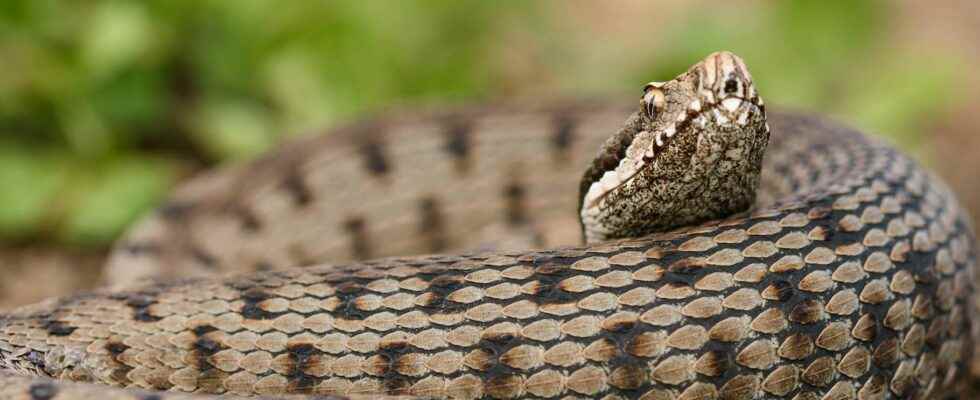From spring until fall, it is not uncommon for our pets, cats and dogs alike, to be bitten by a snake. Especially by a viper. The trouble is that the latter injects a dangerous venom for the animal. It is then urgent to consult a veterinarian. And in the meantime, a few first aid gestures can help.
You will also be interested
[EN VIDÉO] Interview: the Gabon viper champion of camouflage We find around the caves of Lastoursville, discreetly lurking in the dead leaves, the viper of Gabon. Laurent Chirio is part of the team exploring these places. Specialist in reptiles and amphibians, he tells us more about this snake during this interview.
In winter, vipers hibernate. But from the months of March or April, they reappear in our countryside. In France, we mainly encounter the asp viper (Vipera aspis) found throughout the territory, the adder (Vipera belus), Orsini’s viper (Vipera ursinii) and Seoane’s viper (Vipera seonaei) which is, however, increasingly rare. And even if we don’t always know how to distinguish them, we fear their poisonous bites.
Also for our animals. Because with the return of sunny days, our cats may go out more. And we generally take our dogs for walks more willingly. A great idea, but watch out for outings edge forest, fields or tall grass. Because in addition to ticks who can hide there, our animals can fall there on a viper which, frightened, could come to bite them.
According to veterinarians, cats usually get their paws bitten. While dogs are attacked in the muzzle. Especially because the vipers can hide in piles of stones or among old branches that dogs like to dig into. All this explains — at least in part — why the consequences of a viper bite are generally more unfortunate for the latter.
A veterinary emergency
First note that a viper bite can be recognized by the presence on your animal’s skin of two small holes separated by 0.5 to 1 centimeter. It’s a painful wound. Thus, if you did not witness the attack, you should be alerted by the complaints of your cat or your dog. After the bite, a edema, necrosis or hemorrhage may occur. And depending on the amount of venom injected by the viper, the animal will suffer fever, seizures, diarrhea, vomiting or even paralysis. Signs that appear between 30 minutes and 3 hours after the bite.
You will therefore have understood: a viper bite is an emergency. The objective is therefore to take your animal as quickly as possible to a veterinary. But in the meantime and to limit the consequences, first try to calm your animal. the stress or an effort accelerate his heart rate and therefore, the progression of the venom in his body. Then try to cool the bite. Using a cold cloth, ice water or even ice cubes. To calm the pain, this time, as much as limiting, again, the spread of venom. You can also try to immobilize the bitten limb.
However, do not usealcohol. If you want disinfect the wound, use an iodine solution such as betadine. Also noanti-venom for human. Do not apply a tourniquet. Do not incise the bite. Don’t try to warm it up either. And even avoid the use of an aspivenin. All of these actions could make the situation worse for your pet.
Interested in what you just read?
